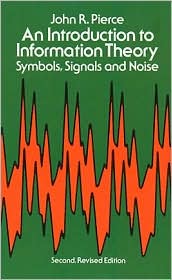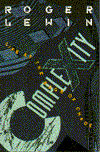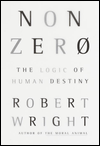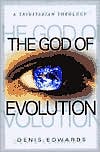The Handmaiden of Design (I.D. XIV)
 |
| Michael Behe |
Behe's claim is that Darwinian evolution by natural selection can produce only step-by-step, cumulative complexity, not all-or-nothing, irreducible complexity. If each new part in an evolving biological system doesn't correspond to a step-up in utility, Darwinian evolution can't cobble it together with other functionless innovations to make a whole new system that does have function.
"Protein machines consisting of numerous distinct proteins, each indispensible for function[, are] beyond what natural selection can muster in a single generation" (p. 148). Yet such "machines" are typical of biological systems. For example, the flagellum of a bacterium is a "whiplike rotary motor which enables a bacterium to navigate through its environment ... [and] requires approximately fifty proteins. Yet the absence of any one of these proteins results in the complete loss of motor function" (ibid.).
In this example, the proteins are the "parts" of the systemic whole that is a bacterium's flagellum. You need to find approximately fifty of them together in one package for the flagellum to work. But mutations in a non-flagellar precursor organism are apt to add new proteins one at a time, not giving natural selection enough to work with until the count very improbably reaches fifty. Or, so Behe's argument goes.
Stuart Kauffman, meanwhile, believes that
... sufficiently complex mixes of chemicals can spontaneously crystallize into systems with the ability to collectively catalyze the network of chemical reactions by which the molecules themselves aer formed. Such collectively autocatalytic sets sustain themselves and reproduce. This is no less than what we call a living metabolism, the tangle of chemical reactions that power every one of our cells. Life, in this view, is an emergent phenomenon arising as the molecular diversity of a prebiotic chemical system increases beyond a threshold of complexity. (At Home in the Universe, p. 24)
Kauffman's computer models show that the requisite threshold of complexity for an autocatalytic set of self-propagating proteins to form is somewhere a number of proteins in the low double digits. His concept of "critical diversity" (see p. 63) is quite similar to Behe's of "irreducible complexity." Remove a single protein from a set that has just barely crossed the threshold of critical diversity, and you no longer have a self-perpetuating set.
There are obvious similarities between a self-organizing, self-perpetuating system that has attained a "critical diversity" which would be lost if one component protein were removed, and a biological system such as a flagellum which is "irreducibly complex," in terms of its functionality. But there are also important differences.
One of the important differences is that the proteins which make up a flagellum presumably cannot be swapped out with other proteins. Replace protein A with protein B, and what you have is no longer a flagellum. In fact, it may no longer by a system.
But in Kauffman's autocatalytic sets, it almost doesn't matter which particular species of proteins come together. As long as the number of proteins in the set reaches the critical threshold, the set can be expected to go autocatalytic.
Proteins are, by the way, chains of molecular building blocks called amino acids. There are but 20 amino acid types. But, since any building block in the protein chain can be any of the 20 amino acids, and since the chain can be very short, very long, or any length in between, the number of possible protein species is very large. Yet when you bring a manageably small number of randomly chosen proteins together, hold them together within some kind of proto-cell wall, and allow energy and small "food" molecules to pass in via the wall, and heat and waste molecules to be dissipated, you achieve "collective catalytic closure" (p. 48) — and life begins.
The difference here is that Kauffman's autocatalytic sets are not specified, to use Dembski's lingo. The specific function of a bacterium's flagellum means that a particular list of proteins will be needed to make it. But, thanks to the fact that, per Kauffman, self-propagation is an emergent phenomenon of any group of proteins that is reasonably large, Dembski's criterion of specificity does not apply.
Notice, though, that it does apply to each protein species per se. Each of the untold possible protein species is virtually unique in terms of the shape of its molecule, which depends on the particular order of the amino acids in it. And it is its shape which more than anything else which determines what a protein does.
Furthermore, the number of proteins in a set with collective catalytic closure is in the low double digits — not enough to make any such set wildly improbable. In terms of Dembski's criterion of complexity, it ranks pretty low. So my guess is that a collectively autocatalytic set does not contain any more CSI (complex specified information) than the sum of the CSI of its protein parts.
Hence, the proteins themselves, which individually have "lots of CSI," represent detectable design, in Dembski's view. Each protein is quite complex, hence improbable; each is unique, hence remarkably possessed of the requisite specificity to justify being called CSI. But the autocatalytic set qua set adds no more CSI, and thus cannot be said to be "designed."
Put another way, the process of cobbling together an autocatalytic set has to do with the flow of complex specified information, not its origination. This conclusion is supported by the fact that Kauffman says these aspects of self-organized complexity are quintessentially lawful, taken along with Dembski's demonstration that natural laws and/or computer-style algorithms cannot originate CSI/design.
At first blush, it might seem as if Kauffman's worldview is downright antagonistic to Dembski's. Kauffman emphasizes types of natural behavior that do not directly implicate design, it is true, while Dembski focuses immediately on design, which he says complex specified information is another name for — CSI and design being isomorpic ways of representing the same thing.
But here's another way to look at it: life is an emergent phenomenon whose "efficient cause," to use the Aristotelian term, is self-organization. But its "final cause" is design.
If antequated Aristotelian causal categories don't seem quite right, though, then I would go so far as to call self-organization the "handmaiden" of design — in much the same way as Kauffman calls self-organization the "handmaiden" of Darwinian natural selection.
I like this "handmaiden of design" metaphor particularly well because it patterns with the idea that design comes from God (presumably masculine), and self-organization comes from nature (presumably feminine). Prettily, moreover, Mary the mother of Jesus responded to the announcing angel who brought her news of what was about to happen to her if she consented, "Behold the handmaid of the Lord; be it unto me according to thy word" (Luke 1:38).


















0 Comments:
Post a Comment
<< Home